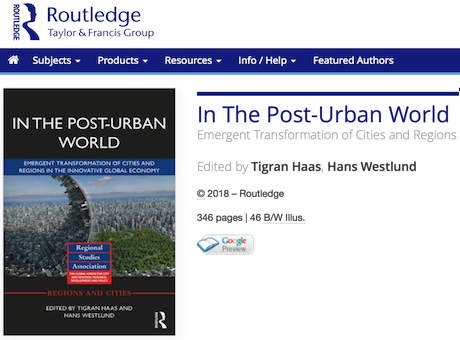This new book edited by Tigran Haas and Hans Westlund from KTH is a collection of interesting and somewhat oblique essays on the urban world we have entered. Lot of people you know writing here. Ed Glaeser, Richard Florida, Patrick Adler, Rahul Mehrotra, Felipe Vera, myself, Hans Westlund, Paul Knox, and Richard Sennett – and that is the first part. And then in two more parts: Jessie Poon, Wei Yin, Kaisa Snellman, Jennifer Silva, Carl Frederick, Robert Putnam, Kyle Farrell, Tigran Haas, Fulong Wu, Karima Kourtit, Peter Nijkamp, Edward Soja, Fran Tonkiss, Laura Burkhalter, Manuel Castells, Saskia Sassen, Susan Fainstein, Emily Talen, Michael Neuman, Nadia Nur, Nina-Marie Lister, Duncan McLaren and Julian Agyeman. You can get a sneak preview using some Google Gizmo that is attached to the site.
In the last few decades, many global cities and towns have experienced unprecedented economic, social, and spatial structural change. Today, we find ourselves at the juncture between entering a post-urban and a post-political world, both presenting new challenges to our metropolitan regions, municipalities, and cities. Many megacities, declining regions and towns are experiencing an increase in the number of complex problems regarding internal relationships, governance, and external connections. In particular, a growing disparity exists between citizens that are socially excluded within declining physical and economic realms and those situated in thriving geographic areas. This book conveys how forces of structural change shape the urban landscape.
In The Post-Urban World is divided into three main sections: Spatial Transformations and the New Geography of Cities and Regions; Urbanization, Knowledge Economies, and Social Structuration; and New Cultures in a Post-Political and Post-Resilient World. One important subject covered in this book, in addition to the spatial and economic forces that shape our regions, cities, and neighbourhoods, is the social, cultural, ecological, and psychological aspects which are also critically involved. Additionally, the urban transformation occurring throughout cities is thoroughly discussed. Written by today’s leading experts in urban studies, this book discusses subjects from different theoretical standpoints, as well as various methodological approaches and perspectives; this is alongside the challenges and new solutions for cities and regions in an interconnected world of global economies.









